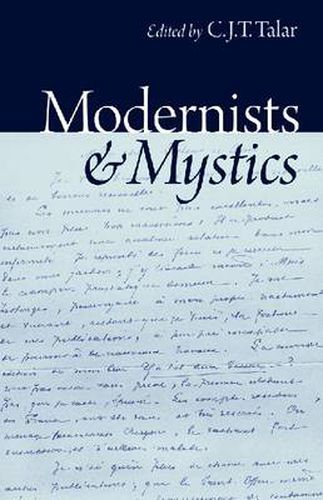Readings Newsletter
Become a Readings Member to make your shopping experience even easier.
Sign in or sign up for free!
You’re not far away from qualifying for FREE standard shipping within Australia
You’ve qualified for FREE standard shipping within Australia
The cart is loading…






Though the figures associated with the Modernist crisis in Roman Catholicism are normally viewed as looking forward in terms of critical history and philosophy, they also looked back in history to the church’s mystical tradition.
Modernists and Mystics
is the first book to tell the story of the Modernist turn to the mystical. It focuses on four diverse modernist-era figures - Friedrich von Hugel, Maurice Blondel, Henri Bremond, and Alfred Loisy - and explores their understanding of mysticism and their relationship to mystics. In the six original essays included in this volume, the authors discuss how von Hugel, Blondel, Bremond, and Loisy all found inspiration in the great mystics of the past. These figures drew inspiration from Fenelon, seeing parallels between the Quietist controversy in which he was deeply involved and the crisis affecting Catholicism in their own day. For them, the reaction against Quietism represented the beginning of a definitive narrowing and suffocating of Catholicism as a living religious tradition. This constriction and hyper-intellectualization of the tradition culminated in the established neoscholasticism of late nineteenth and early twentieth-century manuals of theology. These Modernists opposed the marginalization of the ‘mystical element’ in religion as well as the consequences that followed from it, and they argued for the restoration of the mystical in the Catholicism of their own time.
Modernists and Mystics
also locates these theologians in the larger debates within Catholicism and within the secular academy. Albert Houtin’s approach to mysticism in his biography of Cecile Bruyere of Solesmes represents a reductive reading of the phenomenon, indebted to the theories of J.M. Charcot. Loisy’s debate with Henri Bergson in the 1930s provides a sense of how mysticism was viewed in the French University. Both von Hugel and Bremond contributed to the widening of Catholic horizons regarding the prevalence and nature of mystical experience, while Blondel contributed the perspective of a Catholic philosopher. The contributions of these figures enrich our understanding of debates over mysticism in the early twentieth century as well as our appreciation of the complexity of the Modernist movement.
$9.00 standard shipping within Australia
FREE standard shipping within Australia for orders over $100.00
Express & International shipping calculated at checkout
Stock availability can be subject to change without notice. We recommend calling the shop or contacting our online team to check availability of low stock items. Please see our Shopping Online page for more details.
Though the figures associated with the Modernist crisis in Roman Catholicism are normally viewed as looking forward in terms of critical history and philosophy, they also looked back in history to the church’s mystical tradition.
Modernists and Mystics
is the first book to tell the story of the Modernist turn to the mystical. It focuses on four diverse modernist-era figures - Friedrich von Hugel, Maurice Blondel, Henri Bremond, and Alfred Loisy - and explores their understanding of mysticism and their relationship to mystics. In the six original essays included in this volume, the authors discuss how von Hugel, Blondel, Bremond, and Loisy all found inspiration in the great mystics of the past. These figures drew inspiration from Fenelon, seeing parallels between the Quietist controversy in which he was deeply involved and the crisis affecting Catholicism in their own day. For them, the reaction against Quietism represented the beginning of a definitive narrowing and suffocating of Catholicism as a living religious tradition. This constriction and hyper-intellectualization of the tradition culminated in the established neoscholasticism of late nineteenth and early twentieth-century manuals of theology. These Modernists opposed the marginalization of the ‘mystical element’ in religion as well as the consequences that followed from it, and they argued for the restoration of the mystical in the Catholicism of their own time.
Modernists and Mystics
also locates these theologians in the larger debates within Catholicism and within the secular academy. Albert Houtin’s approach to mysticism in his biography of Cecile Bruyere of Solesmes represents a reductive reading of the phenomenon, indebted to the theories of J.M. Charcot. Loisy’s debate with Henri Bergson in the 1930s provides a sense of how mysticism was viewed in the French University. Both von Hugel and Bremond contributed to the widening of Catholic horizons regarding the prevalence and nature of mystical experience, while Blondel contributed the perspective of a Catholic philosopher. The contributions of these figures enrich our understanding of debates over mysticism in the early twentieth century as well as our appreciation of the complexity of the Modernist movement.